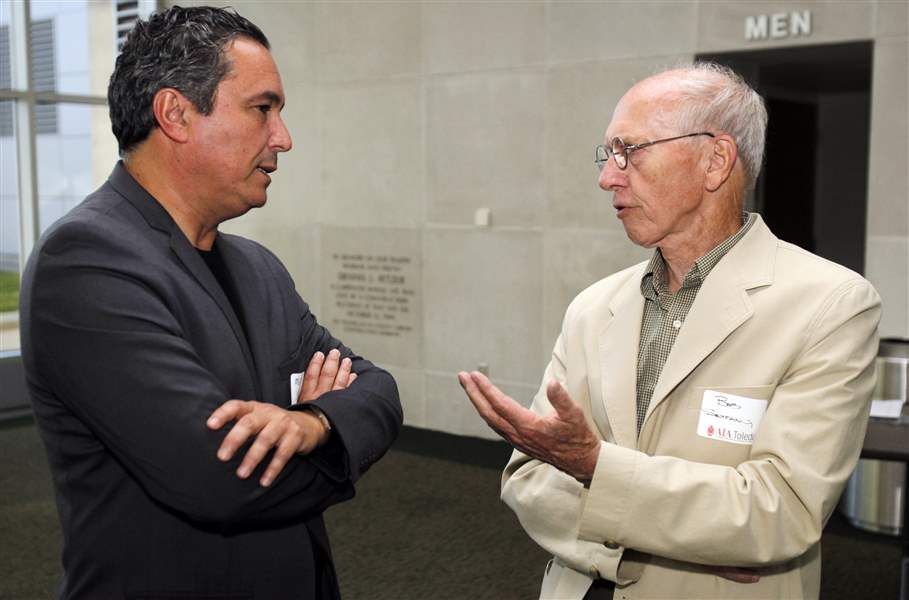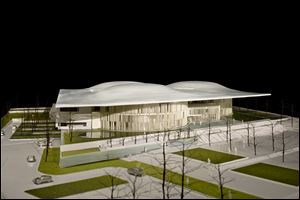
Design set for federal courthouse in Toledo
$96M project proposed for downtown Toledo
6/15/2011
Mehrdad Yazdani, left, architect for the federal courthouse, talks with Toledo architect Bob Seyfang before Mr. Yazdani's presentation at the main Toledo-Lucas County Public Library downtown.
THE BLADE/LORI KING
Buy This Image

A model of the design shows liberal use of glass to provide natural light to courtrooms. The building would go on the Civic Center Mall, facing the county courthouse.
When most people think of an American courthouse, they think of tall columns, an elevated ground floor, and a majestic entrance.
The new, contemporary design for the federal courthouse in Toledo may be far from traditional, U.S. District Judge James Carr said, but if it is built, the building will be both "fulfilling to the purposes of a courthouse" and "a magnificent piece of architecture."
The new courthouse -- to be built on the Civic Center Mall if federal funding comes through and it comes to fruition -- is expected to cost $96 million.
It would face the Lucas County Courthouse.
RELATED ARTICLE: Ambitious building designs invite debate
The 1932 courthouse on Spielbusch Avenue would not be torn down, but would continue to house bankruptcy court, and other federal agencies would move in.
The modern, forward-looking design has stirred questions about how the new courthouse's architecture would relate to the classic architecture of the rest of the city, and how important tradition is to the civic building.
The building's architect, Mehrdad Yazdani, whose Los Angeles studio was selected by a committee in 2004, unveiled the design while in Toledo Tuesday, at a lecture on his architectural philosophy at the main Toledo-Lucas County Public Library. A final design approval by officials is expected next week.
The architect said his design in no way attempts to either mimic or compete with existing buildings in the Civic Center Mall. It simply offers a more functional interpretation of the courthouse that responds and adds to the history of its surroundings.
"Cities grow and cities evolve throughout the centuries," Mr. Yazdani said. "New buildings should have a successful dialogue with previous buildings."

Mehrdad Yazdani, left, architect for the federal courthouse, talks with Toledo architect Bob Seyfang before Mr. Yazdani's presentation at the main Toledo-Lucas County Public Library downtown.
Mr. Yazdani said he recognizes the building is not what most would expect from a courthouse, but that it will be sustainable, high-performing, and timeless.
"We need to relate the immediate context of [the civic mall] with the broader downtown Toledo," he said.
Judge Carr is excited about the design, which he said he thinks would be a great development for downtown Toledo, but most important would improve security at the courthouse -- the judge's primary concern with the current structure.
He said the current courthouse security is outdated, with only a single entrance.
"We have no means of separately bringing in prisoners; they all come through public areas, public elevators," he said.
Mr. Yazdani said he retained many aspects of a traditional courthouse in his design. The courthouse itself is elevated on a kind of porch, a common trait of traditional courthouses. It also has a grand staircase.
"When you dissect the design elements, they refer to traditional courthouses," he said. "When put together, they respond to function."
Talk of building a new courthouse began in 1996, Judge Carr said, but didn't move forward much for about eight years.
Then in 2004, the U.S. General Services Administration held a contest to determine what design studio would lead the Toledo courthouse project. He said the committee reviewed between 50 to 60 initial proposals. The group was composed of a court representative -- Judge Carr -- members of the GSA, and an architect.
The committee narrowed the contestants down to five finalists, finally choosing the Yazdani Studio for design.
Development of the project, however, came to a screeching halt.
"Literally the day after we selected the architect, I received a letter from the government that further work would be suspended," Judge Carr said.
The plans for the new courthouse were put on hold in 2004 when federal judges voted to delay court-construction projects around the country as a cost-cutting measure. In 2007, Toledo's federal courthouse project was removed from the shelf and entered the design phase. The costs of that phase were not immediately available Tuesday.
The project, however, remains dormant until Congress authorizes funding from a courthouse construction fund. Judge Carr said he doubts that will happen in the next four to five years, although there is no definite timetable.
''We are in the process of giving final approval to the design," the judge said. "Unfortunately, we have to await the appropriation from Congress on construction."
Besides security, Mr. Yazdani focused on using natural light in the courtrooms. Courtrooms are traditionally dark, but the natural light will be more energy-efficient, officials said.
The courthouse design has pedestrian access to the Civic Center Mall, opening up the green space between the buildings.
Judge Carr said the relationship with the Yazdani Studio has been "as smooth as possible, and the collaboration has resulted in an "innovative and skillful design."
"It has been a very interesting, productive, and enjoyable collaboration," Judge Carr said. "Among many other attributes of Mehrdad Yazdani is that throughout the entire process, he and the people working with him were very attentive to cost."
Now that the designs are in hand, Judge Carr said it's time for the courthouse to evolve.
"This building was built in 1932, probably one of the last traditional-style federal courthouses constructed, and then they went into a phase when they abandoned this federal style," Judge Carr said. "Principally, we've outgrown it."
Contact Sara Felsenstein at: sfelsenstein@theblade.com or 419-724-6050.